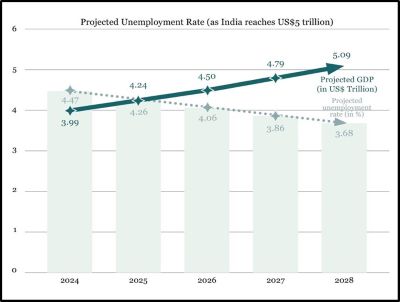Context-
India’s job market is experiencing a transformation as the country has become the world’s fastest-growing large economy in the aftermath of the COVID-19 pandemic. The country’s young population, whose median age is 28.4 years, holds a key to fuelling economic expansion. With a GDP growth rate of 7.8 percent, India could potentially achieve its target of becoming a US$ 5 trillion economy by 2026-27, with such growth being underpinned by strong private consumption and public investment.
Shift in Global Landscape: Opportunity for India
These goals are set against the ongoing shifts in the global landscape and dynamics of manufacturing, brought about by the pandemic, geopolitical tensions, and supply disruptions. Notably, the import demand of the United States (US) has pivoted away from China towards India due to the latter’s competitive cost structure, abundant labour resources, and burgeoning domestic market. In India, manufacturing is a vital sector that has consistently contributed 17-19 percent to the Gross Value Added (GVA). The Indian government has prioritized manufacturing through initiatives such as Make in India, Production Linked Incentive Schemes, and SAMARTH Udyog. The service sector also contributes a significant share to the GVA, exhibiting potential for generating employment and boosting economic growth.
Despite its contributions to the economy, employment in the manufacturing sector has stagnated and even declined, especially in the urban sector, over the last decade. Technological advancements have led to a declining capital-to-output ratio and an increasing capital-to-labour ratio, which raise questions about the manufacturing sector’s capacity to continue absorbing India’s expanding workforce. The employment outlook for India’s manufacturing sector suggests that overall employment in the sector will continue to decline.
Which job markets should India’s youth look to in the next decade?
With the highest employment elasticity to economic growth, India’s service sector presents a promising outlook. This report illuminates ten opportunity sub-sectors within the service sector that have the greatest potential for growth and employment generation for the Indian economy by 2030. These opportunity sectors are digital services (Fourth Industrial Revolution or 4IR, content economy); financial services (banking and insurance); health services; hospitality services; consumer retail services; global capability centers; renewable energy; e-commerce; MSMEs; and the startup ecosystem. Together, these sectors have the potential to create more than 100 million new jobs by 2030.
Projected Unemployment Rate in India

Policy Recommendations for Inclusive Growth
To support India's expanding employment outlook over the next decade, key policy recommendations are proposed:
● Enhancing Employability and Productivity: Collaborate with educational institutions, private sector employers, and civil society to identify employability gaps and align curriculum and programs with evolving labor market needs.
● Diversifying Skill Sets: Nurture cutting-edge technology skills and technology-proof job skills through formal mentorship programs and bridge courses for continuous human capital development.
● Prioritizing Service Industries: Facilitate natural transitions in employment sectors, prioritizing high employment elasticity domains like tourism, hospitality, financial services, and healthcare to absorb surplus labor from manufacturing advancements.
● Stimulating Entrepreneurship: Create an enabling environment for entrepreneurship to stimulate job creation and support the expansion of the startup ecosystem, empowering female workforce participation.
● Public-Private Collaboration: Develop job-ready, semi-skilled, and skilled workforces through public-private collaboration, establishing or strengthening R&D departments within businesses to foster innovation and create employment opportunities.
● Leveraging Government Initiatives for Employment Stimulus: Harnessing India's employment opportunities requires leveraging existing government policies and initiatives:
● Digital India
● Pradhan Mantri Kaushal Vikas Yojana (PMKVY)
● Startup India
● Production Linked Incentive (PLI) Schemes
● PM Vishwakarma Yojana
Additionally, negotiating mutually beneficial trade agreements, particularly for labor-intensive export sectors, can attract investments and create jobs.
Conclusion
India's employment outlook for 2030 presents a landscape of challenges and opportunities. Coordinated action by stakeholders, including individuals, the private sector, civil society, and the government, is essential to realize India's vision of a digitally empowered, skilled, innovative, and self-reliant economy. By prioritizing job creation in high-potential service sectors and implementing targeted policies, India can effectively transform its job market for the next decade, ensuring inclusive growth and economic prosperity.
|
Probable Questions for UPSC Mains Exam- Question 1: How has India's job market transformed post-COVID-19, and what are the key drivers behind the country's goal of achieving a US$ 5 trillion economy by 2026-27? Discuss the role of the service sector in job creation, focusing on specific sub-sectors poised for significant employment generation by 2030. (10 Marks, 150 Words) Question 2: Assess the employment prospects in India's manufacturing sector amid technological advancements and evolving global dynamics. Identify the challenges facing manufacturing employment, especially in urban areas, and propose policy measures to promote inclusive growth through job creation. (15 Marks, 250 Words) |
Source- ORF







